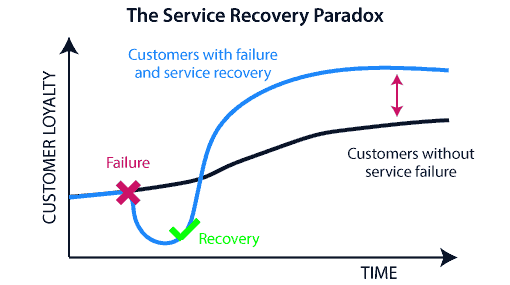Consumers have never had a greater choice of products and services to choose from. This, in turn, means that providing exceptional customer service has become a greater challenge. Putting the customer first is imperative and dissuading customers to switch from one provider to another is no longer about price or product, but how you make them feel and if your reputation holds well in the eyes of previous clients.

To reinforce this idea, we have collaborated with customer service expert, Paolo Fabrizio, to show how your company can start selling with customer service.
1 – Turn Support into a Business Driver
Customer service can cross traditional boundaries (provide assistance) by collecting and capitalizing on customer feedback. Analytics and reports can enable agents to upsell and pass on the information to sales.
Customer service representatives should communicate with customers frequently and analyze their activities using a product or service to identify opportunities to upsell and cross-sell new products and features at the right time.
Choosing the correct moment to offer an upsell or cross-sell can make a difference between coming across as a pushy or helpful. For example, if your customer has successfully enjoyed using your product for a few months, you will be the best person to mention another product they can use with it — or alongside it — to get better results.
If Customer Service shares such feedback with Marketing and Sales, they can target those customers who have just had a great experience to prepare up/cross-selling offers tailored to their specific needs. Of course, that’s beneficial for the Customer Lifetime Value, therefore for the whole company rapidly enjoying great returns.

2 – Make it easy for customers to contact you
The period of time from when customers obtain post-sales support has been reduced by digital technology, generating new possibilities to create revenue through customer service. The majority of the revenue from the customer relationship occurs post-sale and once that happens you need to give them reasons to stay. Providing efficient and productive customer service to solve their problems is key. You have to emphasize the importance of success in the resolution of an issue.
Digital channels allow to have a more continuous conversation and develop knowledge of customers. In the past, companies developed channel-specific support models that compete for mastery. However, in the eyes of the customer, it’s a single organization and the result is diminished customer experience. Instead, an omni-channel customer service approach is required that blends both digital channels and traditional channels.
In this path, the different support touchpoints are designed to complement each other, allowing users to switch between channels without the need to repeat information. Furthermore, multiple channels can be used simultaneously (for example, browsing a physical store while ordering the goods for home delivery from a mobile device).
Brands are tested every time a customer engages with them through digital channels. It’s crucial to taking care of every single conversation to earn a customer’s trust.

If the agent offers a service that fixes the customer problem, then that’s both a sale for the business and a happy customer with their problem resolved.
By doing so they also get another great benefit: customers won’t consider you anymore as just a provider but as a partner. That’s the best assist for your Marketing colleagues to fine tune-up & cross-selling activities.

3 – Train agents on Sales activities
Agents need to be skillfully trained as experts on the products or services you offer. They need to be creative and should be able to come up with workable solutions for any problems thrown their way.
While agents are usually experts regarding the company’s products and services, they have a skill gap when it comes to providing support through digital channels (social media, live chat, messaging apps) where the tone of voice and dynamics are very different compared to phone or email.
So that’s where an ad hoc training becomes essential in order to avoid pitfalls that lead to bad digital customer experiences.
They need to have a “sales” culture and know they can go beyond simple assistance. Honesty can foster loyalty from customers in the long run if their issues are resolved appropriately.
This attitude to go beyond a simple answer is paramount when dealing with customers on public channels, such as social media and online reviews (e.g. Trustpilot, GoogleMyBusiness) because you also speak to an audience of spectators.
Enabling agents to bring some personality to the role is critical because it allows advisors to change the way that they handle each conversation. Make sure that agents’ suggestions fit the customer’s exact need rather than waffle about a non-essential product.
Of course, guidelines need to be set, shared and applied however customers want to deal with real persons representing a human brand: TIP: avoid writing ‘canned responses’ (same responses given to different customers) and want to have even and that.
Think about incentives to encourage them to adopt a sales approach (recognition of the best “seller” each month, bonus…). Plus they need to be empowered to seek sales opportunities should result in gains and accessibility for customers – a real win-win situation.

4 – Proactively assist customers
A trend in customer service is being proactive (anticipating when a customer has a need) instead of reactive (waiting for a customer to contact us). Organizations need to understand the entire customer journey and not just optimize contact points individually. Building unified and pro-active cross-channel services will deliver differentiated customer experiences that drive loyalty and repeat sales.
This strategy can be adapted to sales: for example, a Telco offering a customer a different mobile data plan when they are about to reach their monthly limit.
This is the link where customer service and marketing build together new ‘up-servicing’ solutions: to give you an example Microsoft launched a program to offer new customers a free-customer solution call in which an expert helps the customer to learn and take advantage of full potential of the software they’ve purchased. That’s an amazing way to do that.
To do so, live-chat is also an excellent way to proactively assist customers: you can prompt them to start the conversation when they need it while browsing your website.

5 – Leverage available data about your customers
Companies have lots of data that can be used to personalize the experience and identify sales opportunities: conversation history, data in the CRM. To truly improve performance, advanced analytics tools should not only increase efficiency and reduce costs but also proactively unlock new revenue.
For example, companies using advanced analytics can analyze the text of previous successful sales and they can proactively tailor particular aspects of a pitch based on the customer’s behavioral profile—for example, if a customer is identified as potentially regretting a purchase they made, the script can highlight a hassle-free return or cancellation policy.
Developing a connected ecosystem enables us to make this information available to agents while they interact with customers. For example, accessing CRM data to know their previous purchases

Conclusion
A successful digital transformation is a way a company can address rising complexity, provide excellent customer experience, and manage operations costs with significant ease.
Companies often talk about identifying customer pain points, and contact centers are a clear opportunity, yet most customers view them with trepidation. The best organizations recognize this as a chance to proactively differentiate themselves from the competition but they can also achieve longevity. By implementing these new tools with features that enhance the journey, companies can more accurately predict what’s coming-allowing them to literally control their own future.
To discover more about Paolo, his first and second books, plus key expert insights. Visit his website, follow him on Twitter and on LinkedIn too.
Originally published Mar 27, 2020, updated Dec 30, 2022






1. Enabling agents to handle conversations through one single dashboard, regardless of the channel
2. Getting valuable customer’s insights through reporting and analytics sections. This feedback is gold because they help improve organization (e.g. staffing based on peak moments as per channels and help understand what the customer likes or dislikes).
Briefly speaking, what customers wish to have as a new product/service that today they’re not getting yet. Just like in any kind of relationship, it’s vital to know it promptly.